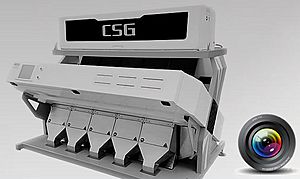Rice color sorting machine facts for kids
Imagine a machine that can look at thousands of tiny rice grains and pick out the bad ones in a blink! That's exactly what a rice color sorter does. It's a special machine that uses cameras to check the color of each rice grain. Its main job is to separate good rice from any bits that don't belong, like small stones, discolored grains, or even tiny pieces of husk. By removing these unwanted parts, the machine makes sure the rice you eat is clean and of the best quality.
Contents
How Rice Sorters Have Grown Over Time
Rice color sorters are not new. They have been helping farmers and rice producers for many years. Over time, these machines have become much smarter and faster. Early sorters were simpler, but today's machines use amazing technology.
Smarter Tech for Better Sorting
Engineers have made big improvements to these machines. They've used:
- Tiny Computer Parts: Called integrated circuitry, these are like the brains of the machine, making it think faster.
- Better Cameras: Camera optics have improved, allowing the machine to see colors and tiny flaws more clearly.
- Quick Ejectors: These are special valves that can shoot out bad grains super fast.
All these improvements mean that modern rice sorters can clean huge amounts of rice very quickly. They also take up less space in a factory, which is great for businesses.
How a Rice Color Sorter Works
Before rice gets to the color sorter, it goes through a few steps at a milling plant. This is where raw rice, called paddy, is prepared. It's boiled, dried, and has its outer shell removed to become the white rice we know.
From Paddy to Perfect Grain
Once the rice is ready, it's sent to the color sorter. Here's what happens inside:
- Rice Travels Up: The rice mixture is lifted by a special belt into a container called a hopper at the top of the machine.
- Sliding Down: From the hopper, the rice slides down smooth channels called chutes. These chutes make sure the grains spread out in a single line, ready to be checked.
- Camera Check: As the rice falls, it passes by special cameras called CCD sensors. These cameras are super sensitive and can spot any grain that looks different in color.
- Bad Grains Get Kicked Out: The moment a camera sees a bad grain, it tells tiny parts called ejectors to act. These ejectors have nozzles connected to air tanks. A puff of compressed air shoots out, pushing the unwanted grain away from the good rice.
What Kinds of Flaws Do They Find?
The color sorter is designed to find many types of defects in rice, such as:
- Grains with black tips
- Chalky (dull, white) grains
- Yellow or discolored grains
- Immature grains (not fully grown)
- Even tiny things like mouse droppings or small stones
By removing these, the machine ensures that only the best, cleanest rice makes it to your plate!
Where Rice Sorters Do Their Job
Rice color sorters work best in a clean, dry, and dust-free place. They usually operate at normal room temperature, between 20 and 45 degrees Celsius (68 to 113 degrees Fahrenheit).
Powering the Sorter
These machines need a few things to run smoothly:
- Air System: They use an air compressor to create the compressed air needed for the ejectors. This air is stored in an air tank and dried before it's used. The air pressure usually needs to be at least 0.2 MPa (megapascals).
- Electricity: The air compressor often uses a stronger power supply (like 380 volts), while the color sorter machine itself typically runs on a standard power supply (like 220 volts).


